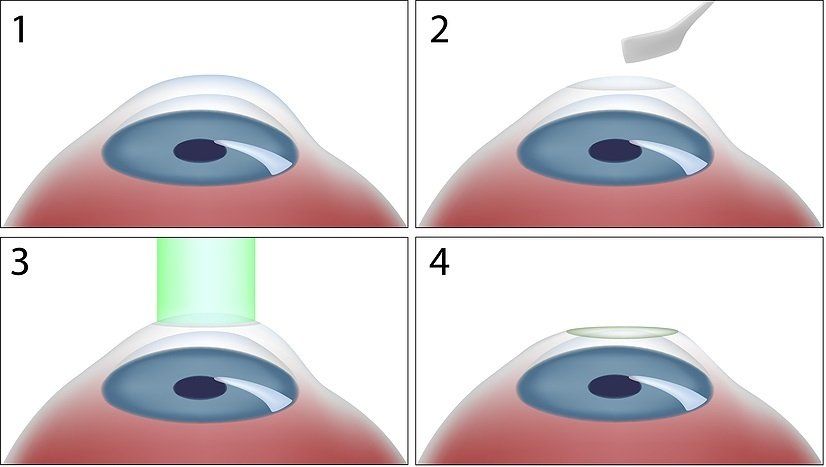LASIK
LASIK (Laser Assisted In-Situ Keratomileusis) is a refractive procedure that involves making a flap with the superficial layers of the cornea and then applying a very precise laser to carve the shape of deeper layers. To make the flap a device called a femtosecond laser is used. When the flap is created, pressure is applied to the eye causing vision to go dark for a short moment, this is normal, and vision will return. After the flap has been cut, it is folded back, the laser is applied and then the flap is put back in place. The procedure usually lasts about 5-10 minutes.
Advantages to LASIK include a quick recovery time and little pain. This allows people to return to work and most activities rather quickly. Disadvantages to LASIK are usually related to the flap. Significant vision loss is very rare, but usually occurs when the flap is being cut. Occasional complications like wrinkles in the flap or inflammation/debris under the flap are usually correctable or insignificant. Common concerns after the surgery are dry eye and glare when driving at night, but with time they usually improve. On very rare occasions flaps have been moved because of eye injuries. A thinner cornea is left after LASIK, and this limits some patients with a really high prescription or thin cornea from having it. Below is a list of items doctors consider when determining if a patient is a candidate for refractive surgery.
LASIK Candidacy
• Have a stable eyeglass prescription and be over the age of 18 years-old
• Have corrected visual acuity of better than 20/40 in both eyes
• Eyeglass prescription within treatable parameters and have enough corneal thickness for the procedure (less than 8 D of myopia, 3 D of astigmatism and 3 D of hyperopia)
• Acceptable wearing reading glasses after 40 years of age
• Free of strabismus (eye turns) or diplopia (prism in glasses)
• No history of retinal detachments or significant eye diseases
• Have overall good health and managed medical conditions
• Currently not pregnant

PRK
PRK (Photorefractive Keratectomy) is a refractive correction procedure that involves removing the front surface of the cornea (the epithelium or “skin”) and then applying the same laser used in LASIK procedures to shape the cornea. Surgeons use a brush or an alcohol application for 30 seconds to remove the epithelium. After the procedure a bandage contact lens is placed on the eye for 4 days to help with comfort and assist healing.
Advantages of PRK are that it leaves you with a thicker cornea and there is no possibility of having any flap complication. It is the recommended treatment for those with a high prescription or thin cornea because of the thicker bed that is left after. Because there is no flap it is recommended for those that are in situations where there is an increased risk of trauma (military, police, fireman, football player, etc…). Disadvantages to PRK are the mild to severe pain that lasts 2-3 days and the slower visual recovery time (4-7 days for “functional” vision and 1-2 months for best vision). Risks with PRK include developing haze with large amounts of correction, which have been reduced substantially with the use of Mitomycin C and infections, which have also been reduced substantially with the use of stronger antibiotics.

PRK laser treatment